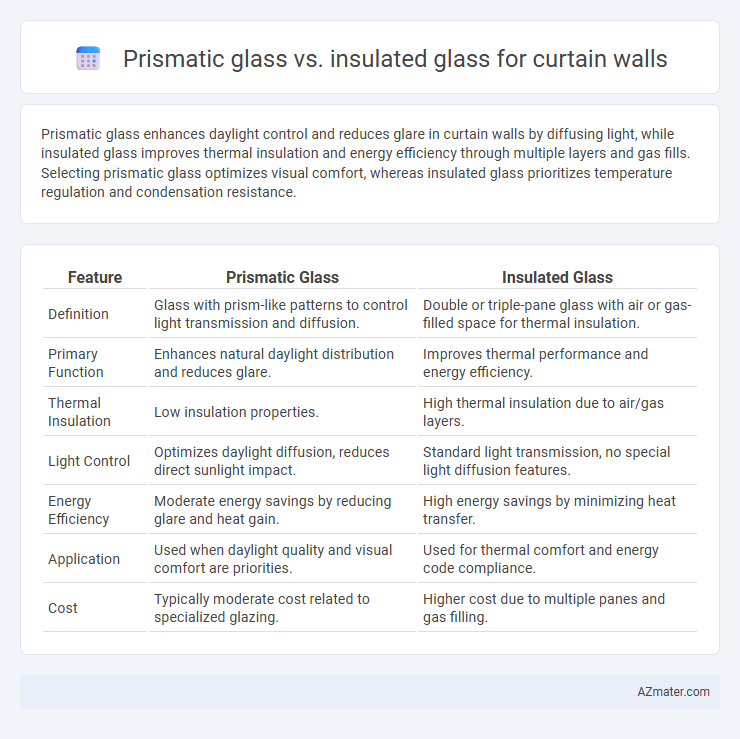Prismatic glass enhances daylight control and reduces glare in curtain walls by diffusing light, while insulated glass improves thermal insulation and energy efficiency through multiple layers and gas fills. Selecting prismatic glass optimizes visual comfort, whereas insulated glass prioritizes temperature regulation and condensation resistance.
Table of Comparison
| Feature | Prismatic Glass | Insulated Glass |
|---|---|---|
| Definition | Glass with prism-like patterns to control light transmission and diffusion. | Double or triple-pane glass with air or gas-filled space for thermal insulation. |
| Primary Function | Enhances natural daylight distribution and reduces glare. | Improves thermal performance and energy efficiency. |
| Thermal Insulation | Low insulation properties. | High thermal insulation due to air/gas layers. |
| Light Control | Optimizes daylight diffusion, reduces direct sunlight impact. | Standard light transmission, no special light diffusion features. |
| Energy Efficiency | Moderate energy savings by reducing glare and heat gain. | High energy savings by minimizing heat transfer. |
| Application | Used when daylight quality and visual comfort are priorities. | Used for thermal comfort and energy code compliance. |
| Cost | Typically moderate cost related to specialized glazing. | Higher cost due to multiple panes and gas filling. |
Introduction to Curtain Wall Glazing Options
Prismatic glass and insulated glass represent two key glazing options for curtain walls, each enhancing building performance in distinct ways. Prismatic glass improves daylight distribution and reduces glare by redirecting sunlight, which contributes to energy savings and occupant comfort. Insulated glass, composed of multiple panes separated by a spacer, offers superior thermal insulation and soundproofing, making it ideal for energy-efficient and noise-sensitive building designs.
Understanding Prismatic Glass: Features and Applications
Prismatic glass enhances natural daylight harvesting in curtain walls by redirecting sunlight deeper into interior spaces, reducing glare while improving energy efficiency. Its micro-structured surface refracts light, making it ideal for office buildings and commercial spaces where balanced illumination and thermal control are critical. Compared to insulated glass, prismatic glass offers superior daylight management though typically requires integration with insulated panels to meet thermal insulation standards.
Insulated Glass: Structure and Benefits
Insulated glass for curtain walls consists of two or more glass panes separated by a spacer filled with air or inert gas, creating a thermal barrier that significantly reduces heat transfer. This structure enhances energy efficiency by improving thermal insulation, reducing condensation, and increasing soundproofing compared to single-pane or prismatic glass. The multilayer configuration of insulated glass also contributes to occupant comfort and supports sustainable building design by lowering HVAC energy consumption.
Thermal Performance Comparison
Prismatic glass enhances thermal performance in curtain walls by diffusing sunlight and reducing solar heat gain, which lowers cooling loads and improves daylight distribution. Insulated glass units (IGUs), typically composed of double or triple panes with inert gas fills and low-emissivity coatings, provide superior thermal insulation by minimizing heat transfer through conduction and convection. Comparing both, insulated glass achieves higher overall U-values and better resistance to heat loss, while prismatic glass focuses more on optimizing solar heat gain control and daylight efficiency in building facades.
Light Transmission and Daylighting Effects
Prismatic glass enhances light transmission through its micro-structured surface, optimizing daylight distribution and reducing glare within curtain wall systems. Insulated glass units (IGUs) typically offer dual-pane layers with air or gas fills, focusing more on thermal insulation while maintaining moderate light transmission and reducing heat gain. Prismatic glass outperforms in directing daylight deeper into interiors, improving natural illumination and energy efficiency compared to standard insulated glass in curtain wall applications.
Energy Efficiency Considerations
Prismatic glass enhances energy efficiency in curtain walls by diffusing sunlight and reducing glare, thereby lowering cooling loads and optimizing natural daylight use. Insulated glass units (IGUs) provide superior thermal insulation through multiple glass panes separated by air or gas-filled spaces, significantly reducing heat transfer and improving U-value performance. Combining prismatic glazing with insulated glass maximizes energy savings by balancing daylight management and thermal resistance, crucial for sustainable building envelopes.
Acoustic Insulation Capabilities
Prismatic glass and insulated glass both play crucial roles in curtain wall systems, but insulated glass offers superior acoustic insulation capabilities by utilizing multiple glass panes separated by air or inert gas layers that significantly reduce sound transmission. Prismatic glass primarily enhances natural light distribution and glare control, providing limited soundproofing benefits compared to insulated glass. For projects prioritizing noise reduction, insulated glass is the preferred choice due to its effective sound attenuation properties suitable for urban and high-noise environments.
Cost Analysis and Budget Factors
Prismatic glass typically incurs higher upfront costs due to its specialized manufacturing process and optical properties, which enhance daylighting and reduce glare in curtain wall systems. Insulated glass offers greater energy efficiency by incorporating multiple panes with gas fills and low-emissivity coatings, often resulting in lower long-term operational expenses despite moderate initial investment. Budget factors must consider lifecycle costs, including installation, maintenance, thermal performance, and potential energy savings when choosing between prismatic and insulated glass for curtain wall applications.
Aesthetic Versatility and Design Impact
Prismatic glass enhances curtain wall aesthetics by dispersing light into multiple colors, creating dynamic and visually striking facades that change with sunlight conditions. Insulated glass prioritizes energy efficiency and thermal performance while offering a sleek, clear appearance that supports minimalist design principles. Combining prismatic and insulated glass can achieve both aesthetic versatility and high-performance insulation for innovative architectural solutions.
Choosing the Right Glass Type for Your Curtain Wall
Prismatic glass enhances daylight distribution and reduces glare in curtain walls, making it ideal for spaces requiring natural light control and energy efficiency. Insulated glass offers superior thermal performance by minimizing heat transfer, thus improving building insulation and reducing energy costs. Selecting the right glass type depends on balancing visual comfort, energy efficiency goals, and environmental conditions specific to the building's location.

Infographic: Prismatic glass vs Insulated glass for Curtain wall
 azmater.com
azmater.com